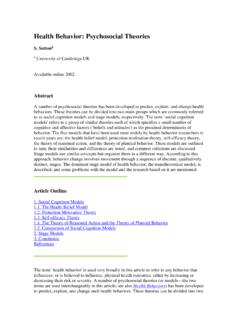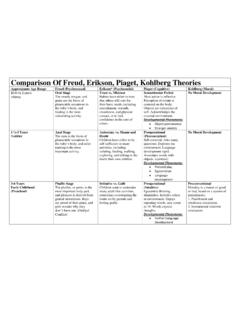Transcription of Community-Based Mental Health and Psychosocial Support …
1 Dr. Zeinab Hijazi (UNICEF Global MHPSS Specialist, NYHQ)Dr. Koen Sevenants(CP AOR MHPSS Coordination Specialist, Geneva)Community-BasedMental Health and Psychosocial Support (MHPSS) UNICEF/UNI197921/SchermbruckerJune 18th, 2020(Slides adapted using Materials from the UNICEF CB MHPSS Orientation package and Dr. Lynne Jones)What is it and how to do itObjectives To Understand: What are the challenges children face today? How do children respond to these challenges? Some theories and concepts What is MHPSS? What do we mean by child development? The Social Ecological Model IASC guidelines Community Based MHPSS MHPSS theory of change 9 circles of Support Community engagement participation and mobilization Key points on Assessment, Monitoring and Evaluation Theory into practice 3 examples of community based programming Further reading and resourcesA Few Initial Questions to on your experience, what are the key challenges facing children in humanitarian settings around the world?
2 And how have those challenges changed and shifted over the past few decades?The unique challenges that today s crises pose for children s safety, well-being and optimal developmentpovertyterrorismand conflictclimate change and ecological collapseunprecedented levels of displacementnatural disasterspandemicsUNICEF, Inter-Agency Guide to the Evaluation of Psychosocial Programming in Emergencies, United Nations Children s Fund, New York, the positive state of being when a person thrives. In Mental Health and Psychosocial work, wellbeing is commonly understood in terms of three domains: Personal wellbeing positive thoughts and emotions such as hopefulness, calm, self-esteem and self-confidence Interpersonal wellbeing nurturing relationships, a sense of belonging, the ability to be close to others Skills and knowledge capacities to learn, make positive decisions, effectively respond to life challenges and express oneself the ability to overcome adversity and positively adapt after challenging or difficult Michael Ungar, in Hague Symposium Report, 2015 Children s resilience relates not only to their innate strengths and coping capacities, but also to the pattern of risk and protective factors in their social and cultural environmentsNot all children are resilient.
3 Some common reactions in children in emergencies include Under five: Regressive behaviour, soiling, wetting, clingy, sleeplessness, nightmares, night terrors, loss of new skills minor illnesses Six to twelve: tearfulness and depression, sleep problems, poor concentration, restlessness, anxiety and fear, aches and pains, regression, aggression. Repetitive play is very common Over twelve: hopelessness, suicidal ideas, self destructive behaviour, risk taking, withdrawal, apathy, somatic complaintsICD 10 Diagnoses in a child and adolescent clinic in Kosovo 1999, one year post conflict Stress related problems most common diagnosis No psychiatric diagnosis -largest group Educational role: what to expect-depathologisingand normalising-contact with appropriate agencies General consensus from research around world is that rates of traumatic stress symptoms around 30%Problems and diagnoses at a child and adolescent psychiatry clinic in Kosovo, two years post conflict (n=385) Behaviouralproblems Enuresis Special needs Serious psychopathology Neuro-developmental problems Physical and sexual abuse hidden problemMental Health services for war affected children: report of a survey in Kosovo, L jones with A.
4 Rrustemi, , , British Journal of Psychiatry(2003) 183: 540-546 What lessons have you learned in your own work about the best ways to promotewellbeing and resilienceamong children in crisis settings?emerging evidence on the determinants of children s resiliencePersonal Factorspersonality, genetic makeup, presence or absence of disabilities Social Factorsrelationships with families, teachers, friendsEnvironmental Factorsaccess to essential servicessafetysense of belonginglessons learned from the evaluation of existing approachesNeed to improve engagement with families and communitiesNeed to improve on the scale and quality of MHPSS interventionsNeed to improve transitions from early emergency response to recovery and regular programming Concepts and TheoriesWhat do we mean by MHPSS? Mental Health : term mostly used by Health actors when talking about preventing or treating Mental disorders Psychosocial : term used by non- Health actors to describe non biological interventions that maintain or improve individual and social well being.
5 Psychosocial wellbeing: The positive state of being when an individual, family or community thrives. Influenced by the interplay of human capacity ( psychological and physical) social ecology and culture and values. (IFRC 2009) The composite term Mental Health and Psychosocial Support -MHPSS is used to describe any type of local or outside Support that aims to protect or promote Psychosocial well-being and/or prevent or treat Mental disorder. (IASC Guidelines 2007) Child Development: the process of change in which a child comes to master more and more complex levels of physical activity, thinking, feeling, communicating and interactions with people and objects. This is sometimes expressed as physical, cognitive, emotional and social development. Children at different stages of development will respond in different ways to humanitarian emergencies and require different interventions to Support their wellbeingWhat do we mean by Child development?
6 The Social Ecological Model views child development and wellbeing as contingent upon contextual factors ( family, community, sociocultural and political influences and the services and structures that surround them)MHPSS interventions in emergencies must consider how best to reach children at each age and developmental stageChildren s wellbeing and resilience are linked to their stage of children as activeagents in their ecosystems, in dealing with adversity and, in turn, influencing their families and communities The Social Ecological SOCIALECOLOGICAL MODELA Question For YouCan you name one protective factor and one risk factor at the FAMILY/CAREGIVER level that could impact a child s well being?Can you name one protective factor and one risk factor at the COMMUNITY level that could impact a child s well being?Can you name one protective factor and one risk factor at the SOCIETY/CULTURE level that could impact a child s well being?
7 What is the IASC MHPSS Pyramid? The IASC MHPSS intervention pyramid shows the four layersin the system of supports for people s recovery and wellbeing inhumanitarian emergencies. This is an adaptation of the IASC MHPSS intervention pyramid that continues to benefit from application in the field and furtherdiscussionamong IASC MHPSS PYRAMIDA Question for YouCan you think of an example intervention for each level of the IASC MHPSS Pyramid?????What does it mean to have a community based Mental Health and Psychosocial Support (MHPSS) approach? A community based MHPSS natural supports and systemsMakes use of community knowledge and capacitiesMust be carried out in line with the principle of do no harm Engages the community in all phases of programmingAddresses interventions at all layers of theIncludes lay and professional services and psychological and social supportsIASC MHPSS PyramidWhat is the MHPSS Theory of Change?
8 The MHPSS theory of Describes how MHPSS interventions directed at the child, the family/caregiver and the community can help to reduce suffering and improve Mental Health and Psychosocial wellbeing includes strategic actions, causes of problems affecting children s wellbeing and barriers to program implementationCan be adaptedand tailored to different contextsWithin the MHPSS Theory of ChangeMHPSS Interventions operate on 3 tiers: child family/caregiver community MHPSS interventions can also be divided into 9 Circles of SupportWhat are the 9 Circles of Support ?9 CIRCLES OFSUPPORTO utputs and Interventions (9 circles)The MHPSST heory of Change PROBLEM: teenage children have missed out on education and have no skills, which contributes to their low self esteem and Mental distress CAUSES: Destruction and closure of schools, flight of teaching staff, children taking on adult responsibilities, forced recruitment BARRIERS: Lack of safe spaces for training, lack of staff, Lack of resources.
9 STRATEGIES: Work across sectors, particularly education and protection to create joint vocational training programmes. Mobilise community to identify mentor figures to provide vocational trainingCommunity Engagement and ParticipationKey pointsa process in partnership with community members as they assess their situation, consider priorities to help children and families and develop solutions based on their needs and Engagement Engage Communities?To ensure programmes:Are relevant to local realities, cultural values and the best use of local resources. Effectively identify children and families who are vulnerable or have special needs, and actively promote their inclusion in interventions and relief the natural supports in families and communities to care for children. Strengthen capacities of child care systems for broad impact. A Question for YouIn your own work, what challenges have you faced around fostering community engagement?
10 How have you overcome those challenges?Engaging communities begins with recognizing and acknowledging their resilience, capacities, skills and resources for self-care and self-protection. It involves:Workingwith the community and its community s dynamics and community capacities and strengths Working in partnership to plan, implement and monitor interventionsSix steps of engagementand participationLearn about the and meet community an inclusive, participatory assessment of needs and inclusive, participatory planning of solutions and programme implementation by community and evaluate interventions Needs AssessmentsTwo useful resources: 2012 WHO-UNHCR Toolkit 2013 IASC AssessmentGuidelinesA Question for YouIn your own work, what has been the importance of M&E?Can you think of a time when you were part of a project that lacked M&E? What happened?Monitoring and Evaluation is important tracking progress towards programme goals01making necessary programmeadjustments 02demonstrating programme outcomes03 UNICEF-supported evaluations should adhere to ethical standards for child protection evaluationsFrom theories to practiceMore Questions for YouConsider the impact of the Pandemic in your community, including lockdown strategies, school closures, physical distancing has the pandemic affected the community?















